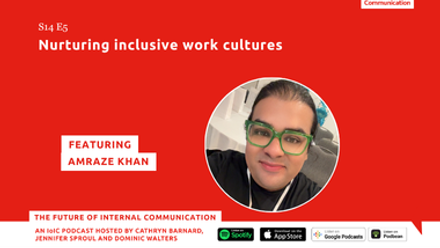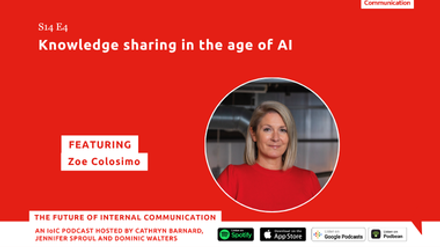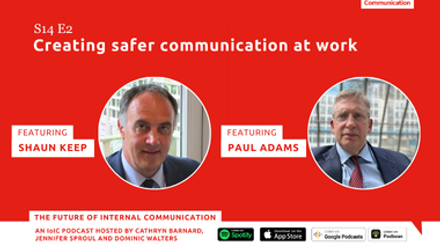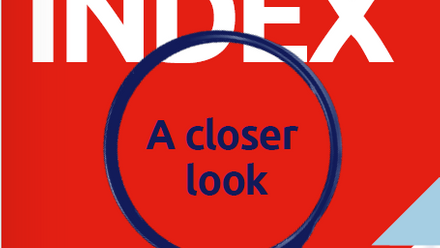I was delighted to be asked to MC the Practical Zone at this year’s fantastic IoIC Festival. This meant I got a front row seat to a series of amazing presentations covering topics ranging from purpose, performance and psychology to verbal communication and the digital experience for employees.
There was a lot to take away, but here are 13 highlights from the four keynote presentations in the Inspiration Zone, which started and ended each day, and the nine Practical Zone sessions.
1. Focus on swing voters in your organisation. Rebecca Crosby and Susanna Holten shared teasers from The IC Index – IoIC and Ipsos Karian and Box’s groundbreaking research (including a survey) of UK employees’ perceptions of internal comms. The results suggest four typical employee personas. Informed Cheerleaders are great for any organisation (obvs), so keep motivating them to spread more joy. Miserable Moaners – who will complain about anything – are probably a lost cause (you’ll unlikely ever fully win them round). So focus on the swing voters who could go either way – Confused Followers and Unconvinced Cynics. Look for opportunities and approaches to convert them into advocates. Also, keep your eye out via ioic.org.uk for the full launch of The IC Index on 5 July.
2. Purposeful thinking has moved to the top of corporate agendas, but businesses need to work out how to align their social impact – the contribution they can make to communities – with their heritage and expertise. And the purpose needs to be presented through an authentic cohesive narrative. Internal comms has a role to bring numerous business commitments and ambitions together into one clear overarching position and vision that makes sense with your heritage. A tough ask.
Debra Sobel advised applying the four Ps of change comms:
- Purpose – explain why you are doing what you are doing.
- Picture – tell people what the change will look like when you reach your goal.
- Plan – how will you get from A to B and in what timeframe?
- Part – explain the part people can play to make change a reality and success.
3. A lot of corporate wellbeing strategies are well intentioned, but don’t always get to the root cause of a health issue. As an example, daily steps challenges for the workforce will help burn calories and keep you fit, but they don’t address the psychology of obesity issues. Lindsay Kohler said that one of the reasons we find it hard to break away from bad habits is that we vastly overestimate our future self control. We think the “future us” will make better choices. (Note to self: stop saying, “The diet starts tomorrow.”) So for your wellbeing initiatives, try and think more deeply about the support you offer.
4. Put things in context for your people. Some may need more explanation about the direction than you think. In the presentation by Suzy Dean and Wes Hackett of AddIn365 and Rachael Snelling from Gatehouse Bank about creating a culture around a new digital employee experience, I liked the point about telling the back story of the bank (or your own organisation). When people join your workforce family, they need to understand the full picture of your culture – where it’s going but also where it came from. And if you launch communities on your website, make sure people know how to use them – and that they are allowed to use them – and where that community is going.
5. Motivating teams to deliver peak performance – the safe ground between boredom and burnout – means paying attention to extrinsic and intrinsic motivations. With her experience as head of IC for Mercedes-AMG Petronas Formula One Team, Nicole Bearne explained the extrinsic factors as rewards and punishment, and summarised three intrinsic drivers internal communicators should keep at the forefront:
- Autonomy – we choose the way we work and that is endorsed by colleagues and leaders, and we are free to speak up.
- Competence – we are experienced, trained, physically fit and confident to do our jobs and we are provided with the equipment we need.
- Relatedness – we are clear on the strategy, connected to the purpose and we feel a sense of belonging at work.
6. Sometimes we can choose our challenges. Sometimes they choose us. It’s about what we do with those challenges that shape us. Mark Pollock’s story of resilience and determination was inspiring. We can be spectators or competitors. And we can be competitive through collaboration – that is how we can make a difference.
7. Deliver content that is in a style people want and try not to put your own influence on it. I loved Ocado’s story – as told by Samantha Fletcher – about introducing a podcast for their drivers, who are out on the road and can’t easily access digital or face-to-face channels. The IC team did research to find out what style of audio the (mostly male) audience liked listening to (Talk Sport featured highly) and did an audio moodboard to find out what people responded to best. A thorough survey after a pilot also shaped the eventual first series of six episodes. They’ve ended up with a great channel called Scan and Deliver, hosted by two Ocado drivers with different but complementary styles of presenting. It feels authentic, open and exactly what their drivers need.
8. According to McKinsey, 70% of employees demand more purposeful work. Emma Tucker, in conversation with Ben Watson, reminded us of author and TED Talker Simon Sinek’s quote: “Profit isn’t a purpose, it’s a result. Purpose is the reason we do the thing that makes the profit.” Does an organisation have to have a social purpose, though? No – not if that is not what the organisation was created for.
9. When offering support around financial wellbeing, show empathy, not sympathy. Financial expert Peter Komolafe says we are all in the same boat (but different parts of the boat). Much like other types of wellbeing, there is always a root cause to a problem. Help people consider the psychology around why they make financial decisions when struggling. Also, if you offer financial coaching at work, you’re on to a winner, says Peter.
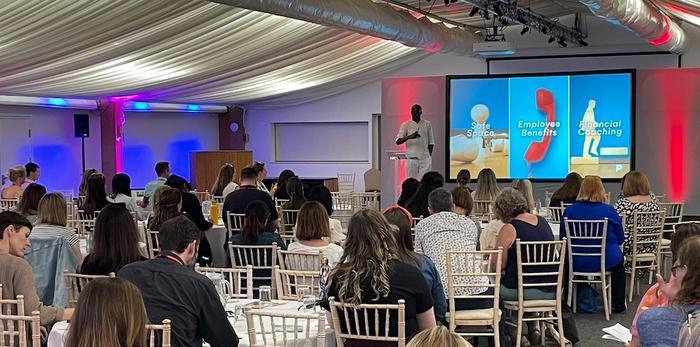
10. Line managers are like Paris Hilton and Nicole Richie – a great comparison from Tarecca Musabbir: they are the original influencers of your organisation. When it comes to verbal comms, you need to know if line managers are having consistent, high-quality conversations. Tarecca advises, ask team members what info they have taken from cascades. Could they rate the team talk? Ask the line managers if the comms pack you sent made sense? How did the news land? What questions did teams have? Use the data to find where there are gaps.
11. When you show vulnerability in your storytelling, empower others through that vulnerability. Remember that everyone has their own individual story, so try not to be generic in your wellbeing storytelling, but balance that by finding stories that resonate with the community. If you can, break down the stigma by leading from the front – tell your own story of how you have been affected. Mahari Hay did this brilliantly for Lloyds Banking Group, working with Limehouse and Nick Howard on a moving mental health campaign around loneliness.
12. Stories work. Tell people about the cultural impact of the work your organisation does (and look for the real heartfelt stuff – show the difference you are making in society). Encourage employees to talk to each other about those stories. Iggy Harris of Publicis Sapient reminded us: moments of shared pride are powerful. Also, I loved Publicis Sapient’s consideration of event “items” for the international premieres of Never Done, an impact film about touching lives through digital: plants on display at venues were later relocated to one of the offices (information cards in the pots told guests this); leftover food went to a charity for the homeless. Let people know you have considered sustainability in all your actions.
13. Don’t let being an outsider deter you. In fact, use it to your advantage. Samuel Kasumu talked about his experiences as the most senior black advisor in government, and his perspective of having a different background to almost everyone he was working with around the table at No.10. Being an outsider can be a source of strength – if you embrace and celebrate what makes you different, it will give you the confidence to start a journey towards achieving big things.


